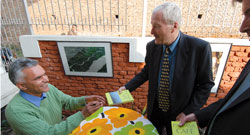|
|
Basain is the most-widely read Nepali novel, not because it was a big bestseller but because it has been required reading in the Tribhuban University curriculum for decades. Hundreds of thousands of Nepalis know the plot by heart because they had to cram it for exams.
The 70-page novel by Lil Bahadur Chhetri evoked a powerful response among Nepalis in Nepal and abroad when it came out in 1958. Chhetri, a descendant of Nepali immigrants, wrote the book in Assam where he still lives. Although he never really stayed in Nepal, he based the portrayal of rural Nepal on interviews with more recent Nepali migrants to Assam.
In his preface, Chhetri had said the main reason for writing the book was to familiarise prabasi Nepalis about the environment and culture of their homeland. "It occurred to me that although the future of people like us, who have made our homes outside Nepal, is tied to the country in which we dwell, our language, literature, and culture are still Nepali, and everyone's own literature and culture are dear to them," Chhetri says.
In 2005, Basain was made into a feature film and on the 50th anniversary of its first edition in 2008, Michael J Hutt has brought out a flawless translation. As professor of Nepali at the School of African and Oriental Studies in London, Hutt has taken great pains to make sure nothing is lost in translation. The slim volume with a preface, glossary, afterword, bibliography and copious footnotes will open a window to Nepal to many for whom the book has so far been out of bounds. And through that window, we see the reality of rural Nepal that hasn't changed much in the five decades since the book was written.
|
|
The caste and gender discrimination, poverty and injustice are more or less intact. But so is the fortitude and generosity of the Nepali spirit portrayed in the book. Entrenched oppression forced generations of Nepalis over the past century-and-half to migrate to the madhes or muglan. Persistent injustice ultimately created the conditions for the Maoist revolution. That struggle finally made Nepalis aware of their rights, but the violence made the economic desperation of many Nepali even worse and triggered a new wave of mass-migration in the past decade that is a modern-day 'Basain'.
'Do they leave their homes because they wish to?' Chhetri asks in the Nepali preface to his 1958 edition, "perhaps that is true for many of them, but for others it is quite a different matter. I chose the misery and mystery that lie at the root of this as the theme of Basain."
The story is set somewhere in the multi-ethnic hills of eastern Nepal. Dhane's family lives a precarious, but contented, existence. A family tragedy and the weight of subjugation by powerful village moneylenders forces him to migrate. This 'misery and mystery' is the story of millions of Nepali families through history.
Today, Nepal's rural youth are selling off ancestral land to pay middlemen to take them to the Gulf or Malaysia, but the wrenching dislocation is the same.
That is also the reason Hutt says he chose to translate Basain: "The way a family's dispossession and flight from Nepal are represented [in the novel] tells us something about the historical fact of migration from the Nepalese hills, as well as reveals the author's attitudes to the fact."
|
|
This is a moving and simple story of a universal family forced to leave home. Thanks to this translation, Basain will touch the hearts of many more people worldwide. acts are even more dramatic than fiction in societies wracked by war.
Nepal's conflict was no different. Nearly 15,000 people were killed and disappeared between 1996-2006, but a novel could be written about each one of them. The story of every family displaced by the conflict could be turned into a feature film.
But we only remember the numbing numbers: 15,000 killed, 1,500 disappeared, 75,000 injured, 250,000 internally displaced and almost the whole country affected in one way or another.
|
|
As the editor of Nepal's largest-circulation newspaper, Narayan Wagle knew well the limitations of journalism in covering war. The news format wasn't the best way to get across to readers how the conflict was brutalising Nepali society. Wagle chose fiction to get closer to the truth.
When Palpasa Caf? came out in 2005, its unusual non-linear style was an instant hit with Nepali readers. It was a fictionalised account of Nepalis caught in the grips of war. Wagle makes a cameo appearance at the beginning of the book and hears of the abduction of a real-life friend by soldiers. He turns his disappeared colleague into an imaginary painter named Drishya, and the rest of the book is about how the conflict sweeps everyone along.
Drishya falls in love with Palpasa, a Nepali American who has returned to the land of her parents after the post-9/11 America. Drishya meets with his childhood friend, Siddhartha, who has joined the Maoists and goes back to their war-torn village in the mountains. The two argue about the age-old questions of art and politics, about peace and justice, about whether the means justify the end.
In the novel's first chapter Wagle, as himself, is sitting at a caf? in Thamel taking dictation on the phone from a district reporter. There has been another battle in the mountains. "That was nothing new," Wagle writes, "we published stories like that every day. Today's newspaper already carried an almost identical story, tomorrow's would as well. It was the same thing every day.did newspapers exist here only to public body counts?"
Something is always lost in translation when novels cross the language barrier. Happily, this one, which got a final polish from Linda Trigg, preserves the original nuances. Narayan Wagle wrote a powerful anti-war novel, delving deeply through his characters at the human cost of conflict. Now, through this English translation, a larger international audience can read about what Nepal's war did to its people.






